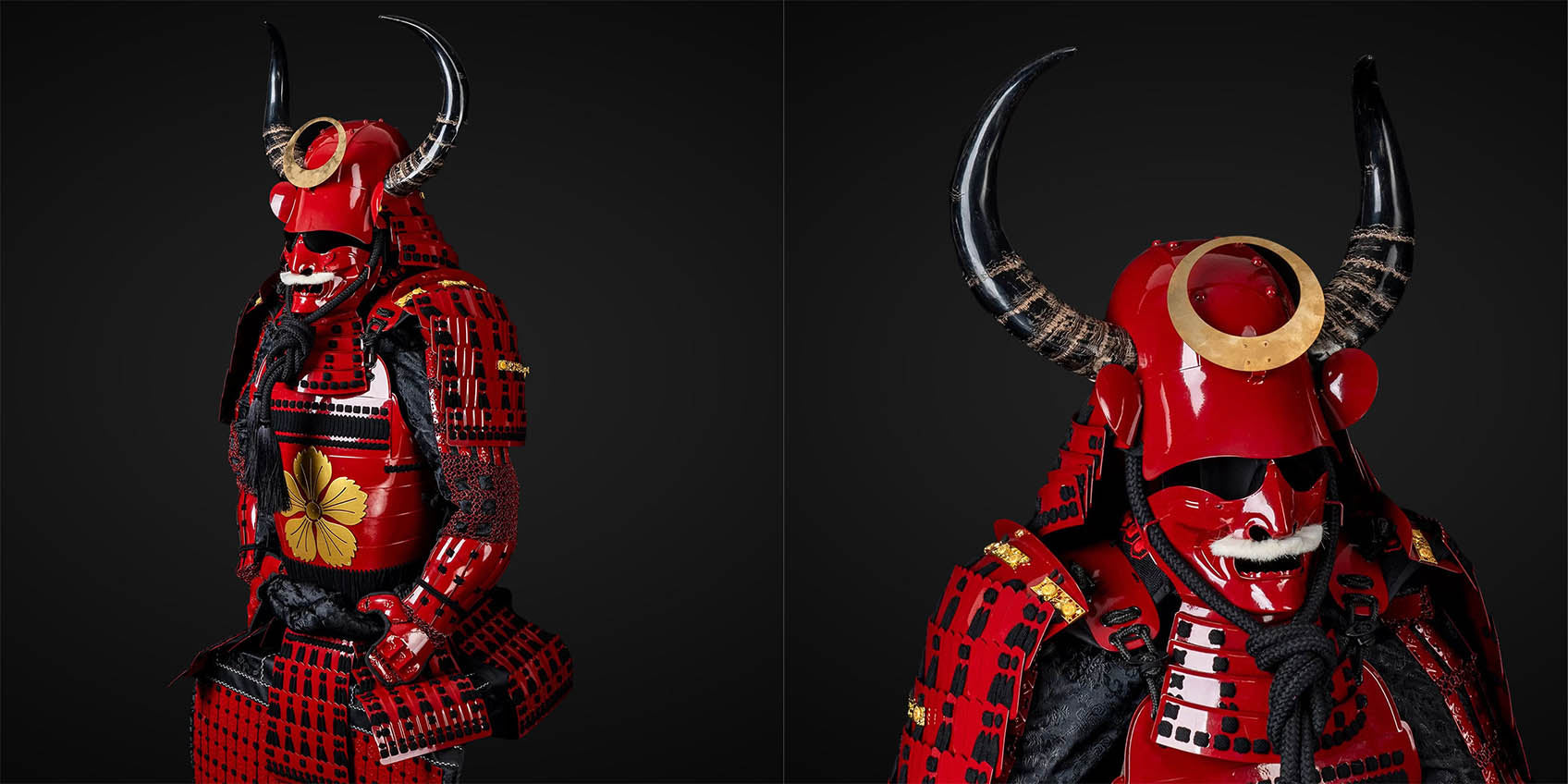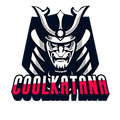Sanada Nobuyuki Red Horned Samurai Armor:A Symbol of Loyalty & Bravery
- Posted by COOLKATANA
-

This Red Horned Samurai Armor is a high-quality replica designed to commemorate the famous Sengoku-period warrior Sanada Nobuyuki. As the eldest son of Sanada Masayuki and the older brother of the legendary Sanada Yukimura, Nobuyuki is renowned in Japanese history for his loyalty, wisdom, and exceptional leadership. This armor not only honors his heroic deeds but also serves as a perfect representation of traditional Japanese samurai culture. Below is a detailed introduction to the armor, offering insight into its design inspiration and historical value.
Sanada Nobuyuki (1566–1658) was the eldest son of Sanada Masayuki and the older brother of the famous samurai Sanada Yukimura. He holds a significant position in the history of the Sengoku period and the early Edo period. Although he was not as well-known for his battlefield bravery as his brother Yukimura, Nobuyuki earned a respected place in history due to his loyalty, wisdom, and sense of family responsibility. After the Siege of Osaka, his loyalty and intelligence were highly appreciated by Tokugawa Ieyasu, which led to his appointment as the first lord of Matsushiro Domain, where he governed for over 40 years.
1. Early Life and Loyalty
Born in 1566, Nobuyuki grew up during a time of intense conflict in Japan. As the heir to the Sanada family, he received rigorous military training and was deeply aware of his family's responsibilities from a young age. The Sanada family experienced numerous upheavals, with his father, Sanada Masayuki, and brother Yukimura playing crucial roles in the Sengoku period, particularly in their strategic relationships with the Toyotomi and Tokugawa families. Nobuyuki demonstrated exceptional intelligence and leadership abilities early on, gradually becoming the pillar of his family.
2. Loyalty and Wisdom in the Siege of Osaka
Though Nobuyuki fought for the opposing side during the Winter and Summer Campaigns of Osaka (1614-1615), siding with the Toyotomi clan, after the Siege of Osaka, he made a different political choice. Ultimately, Nobuyuki firmly pledged loyalty to Tokugawa Ieyasu and provided crucial support, which earned him the trust and favor of the Tokugawa shogunate. This decision, although it strained his relationship with his brother Yukimura, played a pivotal role in his rise within the Tokugawa ranks.
3. Establishing and Governing Matsushiro Domain
After the Siege of Osaka, Nobuyuki was appointed by Tokugawa Ieyasu as the first lord of Matsushiro Domain, where he ruled for over 40 years. His governance was marked by stability and prosperity. He not only preserved the family legacy but also implemented pragmatic policies focused on agricultural development and local economic growth. Under his leadership, Matsushiro prospered, maintaining peace and a thriving economy throughout his reign.
Nobuyuki was skilled in balancing political power and recognized the importance of family honor. He worked for the well-being of his people while promoting cooperation with other Tokugawa vassals.
What is the samurai armor called?
Yoroi refers to the full set of traditional armor worn by samurai. It consists of various components such as the dō (torso armor), kote (armored sleeves), sode (shoulder guards), haidate (thigh guards), and kebiki (shin guards). These pieces were often made of metal, leather, and silk, designed to offer protection in battle while still allowing movement.
History and Cultural Background of Japanese Armor
Japanese armor has a long history, dating back to the Yayoi period (300 BCE – 300 CE). However, it was during the Sengoku period (1467-1603) that armor design reached its peak due to the intensification of warfare and evolving battle tactics. Sengoku-era samurai armor not only focused on protection but also emphasized cultural, spiritual, and honor-related symbolism.
Samurai armor design prioritized both functionality and aesthetics. The colors, shapes, materials, and decorations on the armor carried rich symbolic meaning. For example, family crests (Kamon) were often displayed on armor, serving as a symbol of the warrior’s identity and loyalty.
Sanada Nobuyuki Red Horned Samurai Armor: A Perfect Fusion of History and Craftsmanship
This Red Horned Samurai Armor embodies the superb craftsmanship of the Sengoku period while perfectly capturing Nobuyuki's identity and authority as a family leader. As the eldest son of Sanada Masayuki and the brother of Sanada Yukimura, Nobuyuki is a key figure in Japanese history, especially recognized for his wisdom and loyalty after the Siege of Osaka. Despite not being able to save his brother Yukimura, Nobuyuki’s intelligence and devotion to Tokugawa Ieyasu earned him great respect.
The Red Horned Samurai Armor faithfully restores Nobuyuki’s historical image by using traditional techniques and modern technology. It captures the samurai spirit of the time, particularly through the red horned helmet, which represents his dignity and distinctive identity.
1. Historical Background and Armor Design Inspiration
Nobuyuki’s legacy is largely built on his loyalty and wisdom, particularly after the Siege of Osaka, when he chose to side with Tokugawa Ieyasu, eventually becoming the first lord of Matsushiro. To honor this historical hero, the Sanada Nobuyuki Red Horned Samurai Armor faithfully replicates the armor he wore at the time, aiming to convey his majesty and bravery on the battlefield.
The design of the armor is inspired by Nobuyuki’s courageous image and military experiences, especially the red horned helmet—a distinctive feature that symbolizes his noble stature and combat prowess. The horned helmet is a striking and symbolic part of the armor, conveying a spirit of fearlessness and strength.
2. Armor Features and Craftsmanship
The armor is crafted by blending traditional techniques and modern technology, with each piece being handcrafted by skilled artisans to ensure historical accuracy and meticulous craftsmanship.
- Red Horned Helmet: The horned helmet is the focal point of the armor, symbolizing Nobuyuki’s authority and strength as a Sengoku-era warlord.
- High-Quality Materials: The armor is constructed from high-quality metals and fabrics, ensuring durability and comfort for the wearer. The exquisite hand-engraving and decorative rivets reflect the fine craftsmanship of the period.
- Historical Accuracy: Each armor is carefully designed based on historical records, museum artifacts, and temple relics to ensure the most accurate reproduction of Nobuyuki’s battlefield attire.
3. Size and Customization Options
The armor is designed to fit individuals of height 170-180 cm and a medium build. To meet the diverse needs of customers, we offer personalized customization options, allowing you to choose different colors, sizes, and accessories to create your own unique samurai armor.
- Standard Size: Suitable for individuals 170-180 cm in height with a medium build.
- Customization Service: Tailor the size, color, and accessories to fit personal preferences for a bespoke armor experience.
4. Functionality and Uses
In addition to its historical and artistic value, this armor has practical applications for various occasions:
- Historical Reenactments: Perfect for historical reenactments, offering participants an immersive experience in the samurai culture of the Sengoku period.
- Stage Performances: Ideal as a theatrical or film prop, it beautifully captures the heroic image of Sanada Nobuyuki.
- Martial Arts Training: Designed with both comfort and stability in mind, this armor is suitable for martial arts demonstrations or training.
- Private Collection: As a work of art, this armor makes a remarkable addition to any collection, providing collectors with a deep connection to Japanese history.
5. Manufacturing and Shipping
Each piece of armor is hand-crafted over a period of 4-6 weeks to ensure every detail is perfect. The armor weighs approximately 44 pounds, with a shipping weight of 55 pounds (including display case and stand). The packaging dimensions are 25 * 30 * 22 inches, ensuring it is securely protected during transport.
Handmade Life-Size Sanada Nobuyuki Clan Samurai Armor – Red Yoroi
6. Conclusion
The Red Horned Samurai Armor is more than just a functional piece of equipment—it is a profound tribute to the historical hero Sanada Nobuyuki. It perfectly recreates the samurai spirit and the glory of the Sanada family, delivering a strong historical and visual impact. Whether as a collector’s item for history enthusiasts or a prop for theatrical performances and reenactments, it offers an unmatched immersive experience.
If you are a lover of Japanese history or samurai culture, this armor is an invaluable addition to your collection.



